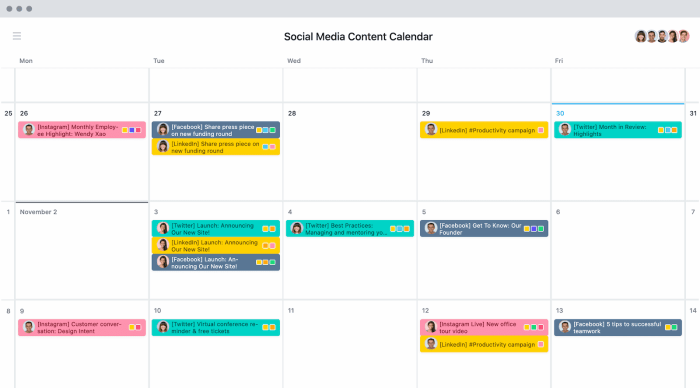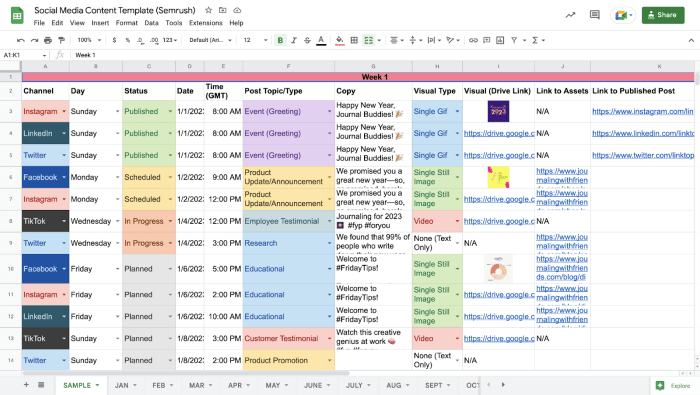Building Social Media Content Calendars sets the foundation for a successful social media strategy, ensuring consistency and organization in your posting schedules. Dive into the world of content planning and creation with this comprehensive guide.
Explore the key elements, tools, and best practices that will elevate your social media presence to new heights.
Importance of Social Media Content Calendars
Having a social media content calendar is like having a game plan for your online presence. It helps you stay organized, consistent, and strategic in your approach to engaging with your audience.
Maintaining Consistency and Organization
- By laying out your content ahead of time, you can ensure a steady stream of posts without any gaps or overlaps.
- Consistency in posting times and frequency helps in building brand recognition and loyalty among your followers.
- Organizing your content in a calendar format allows you to see the big picture and plan for upcoming events, promotions, or campaigns.
Benefits of Using Content Calendars
- Improved Time Management: You can schedule posts in advance, freeing up time for real-time engagement and community management.
- Enhanced Creativity: Planning content in advance gives you the space to brainstorm ideas and create more engaging and innovative posts.
- Better Analytics: By tracking the performance of your scheduled content, you can identify trends, preferences, and areas for improvement.
Components of a Social Media Content Calendar: Building Social Media Content Calendars

Creating a social media content calendar involves several key components that are essential for successful planning and execution of your social media strategy.
Content Types
- Differentiate between various content types such as images, videos, blog posts, infographics, etc.
- Ensure a good mix of content to keep your audience engaged and interested.
- Consider the platform-specific requirements for each content type.
Posting Schedule
- Establish a consistent posting schedule to maintain a regular presence on social media.
- Take into account peak times when your audience is most active to maximize engagement.
- Use scheduling tools to plan and automate your posts for efficiency.
Captions and Hashtags
- Create engaging captions that resonate with your audience and complement your content.
- Research and use relevant hashtags to increase visibility and reach on social media platforms.
- Experiment with different caption styles and hashtags to see what works best for your brand.
Categorizing Content Themes
- Organize your content calendar based on themes or campaigns to maintain consistency and alignment with your brand messaging.
- Assign specific content types to each theme or campaign to ensure a cohesive content strategy.
- Track the performance of each theme to identify successful strategies and areas for improvement.
Setting Goals and KPIs
- Define clear goals for your social media content calendar, such as increasing brand awareness, driving website traffic, or generating leads.
- Establish key performance indicators (KPIs) to measure the success of your content strategy and track progress towards your goals.
- Regularly review and adjust your goals and KPIs based on performance data to optimize your social media efforts.
Tools for Building Social Media Content Calendars
When it comes to creating and managing social media content calendars, having the right tools can make a world of difference. There are several popular tools and software options available that can help streamline the process and ensure your content is organized and consistent.
Social Media Management Platforms
- Sprout Social: Known for its user-friendly interface and robust scheduling capabilities, Sprout Social is a popular choice for businesses of all sizes.
- Hootsuite: Another widely used platform, Hootsuite offers features like social listening, analytics, and team collaboration tools.
- Buffer: With a focus on simplicity, Buffer allows users to schedule posts across multiple social media channels with ease.
Content Calendar Tools
- CoSchedule: This all-in-one marketing calendar allows users to plan and execute their social media campaigns alongside other marketing activities.
- Trello: While not specifically designed for social media, Trello’s visual interface makes it a popular choice for creating content calendars and collaborating with team members.
- Asana: Known for its project management capabilities, Asana can also be used to create and manage social media content calendars.
Choosing the Right Tool, Building Social Media Content Calendars
Before selecting a tool for your social media content calendar, consider your specific needs and budget. Look for features like scheduling, analytics, collaboration, and ease of use. It’s also important to ensure the tool integrates seamlessly with your existing systems and workflows. Take advantage of free trials or demos to test out different tools and see which one works best for your team.
Best Practices for Creating Engaging Content

When it comes to creating engaging content for social media, it’s essential to think outside the box and tailor your posts to each specific platform. By following these best practices, you can maximize audience engagement and drive better results for your brand.
Creating Diverse and Engaging Content
- Utilize a mix of content formats such as images, videos, carousels, and stories to keep your audience interested and entertained.
- Adapt your tone and style to fit the platform you’re posting on – what works on Twitter might not work on Instagram.
- Experiment with different types of content like polls, quizzes, and user-generated content to encourage interaction.
Repurposing Content Effectively
- Repurpose successful content across different platforms to reach a wider audience without having to create new material from scratch.
- Update and refresh evergreen content to keep it relevant and engaging for your followers.
- Create content series or themes that can be repurposed and revisited over time to maintain consistency.
Analyzing Insights and Metrics
- Regularly review analytics data to understand what content is resonating with your audience and adjust your strategy accordingly.
- Identify trends in engagement, reach, and conversions to refine your content calendar and optimize performance.
- Use A/B testing to experiment with different types of content and messaging to see what drives the best results.






